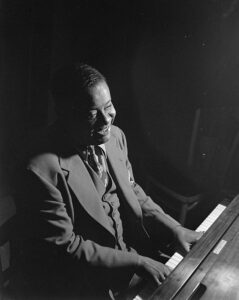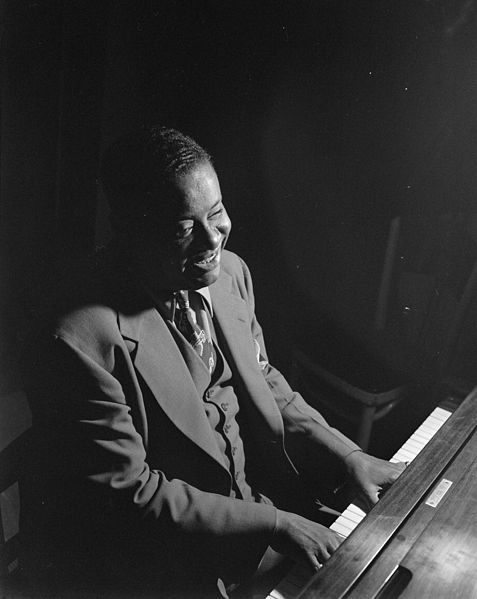
Art Tatum may have been the greatest pianist ever. Here are 5 jazz piano lessons he can teach us.
Lesson 1: Learn from everyone
In addition to learning jazz, Tatum spent years studying the great classical composers, and many of their techniques found their way into his playing. Whether he was playing Chopin-like arpeggios with his left hand, or Romantic-era melodic ornamentation with his right, Tatum drew upon everything he could and made it part of his overall musical vision.
But he didn’t stop there. Tatum even learned from “lesser” pianists whom others ignored. My piano teacher, Billy Taylor, knew Tatum well and told me a story about one night when he and Art were listening to a pianist in a nightclub. Taylor didn’t think the pianist was very good and asked Art if they could go somewhere else. But Tatum said that he was enjoying the guy’s playing and wanted to stay and listen. Billy couldn’t understand why the great Art Tatum would want to listen to this unaccomplished pianist play. The next night, however, he heard Tatum play something that was clearly influenced by the pianist they had heard the night before. Art Tatum had heard something special in the guy’s playing that Billy Taylor had missed. Tatum learned from everyone!
Lesson 2: Don’t be afraid to play “arrangements”
Even though jazz is an improvised art from, this doesn’t mean that you can’t make arrangements of some songs. Art Tatum would sometimes play the same arrangement of a tune like “Willow Weep For Me” over and over for years. His listeners liked to hear him play songs the way he had played them on the recording, and he happily obliged. Don’t be afraid to do this too, and don’t feel like you have to start all over every time you play. Pick a tune and create an intro you like. Then come up with a unique way to play the melody. And then an interesting ending. Use these as the basic elements of an arrangement that you can use whenever you play that tune. This will help give you confidence, too, since you’ll have something solid to rely on whenever you play that tune in public.
Lesson 3: Embrace the melody
Tatum loved melody, and would often embellish the song’s melody instead of improvising a completely new solo. Try this for yourself the next time you play in public. Chances are, your listeners will enjoy it too. Think of it as improvising a set of variations on a theme!
Lesson 4: Reharmonization
Tatum liked to change a tune’s harmony, sometimes making each ‘A’ section sound slightly different. Reharmonization is actually one of the most accessible “takeaways” we can get from Tatum’s playing. Even though he may have played a million notes, the underlying chord substitutions he used may be very easy to assimilate into your own playing.
Here’s what to do:
Look at a transcription of Tatum’s playing of a jazz standard that you know. (This way you’ll easily be able to recognize when he adds or changes chords.) Let’s say the original chord progression is the common Cmaj7/Am7/Dm7/G7. Now look at the Tatum transcription and write the chord names in pencil above each measure, based on what he actually plays. After doing this, you may see that instead of the original progression that you usually use, he plays CMaj7 F7/Em7 Ebdim7/Dmt Ab7/G7. There’s quite a few more chords in there, but they’re all easy. Now you can simply play the song again, and substitute Tatum’s chords instead of your own. You don’t need to play his fancy chord voicings at all. Just play the chords he used, with whatever voicings come naturally to you. This is a great way to expand your harmonic vocabulary and learn how to reharmonize tunes, without becoming overwhelmed by Tatum’s technique.
Lesson 5: Vary your accompaniment patterns
Tatum rarely played the same left hand accompaniment pattern throughout an entire chorus. Instead, he’d play chorale-style held chords for a measure or two, followed by rhythmic “hits,” and then he’d break into a relaxed stride pattern for a few measures before launching into yet another pianistic texture. Again, don’t feel like you have to copy him exactly, since this is almost impossible anyway. Instead, try this technique yourself and freely go from one left hand accompaniment texture to another as you work your way through a tune. Doing this may add additional dimensions to your interpretations of jazz tunes.
So you see my point here: you don’t have to copy Art Tatum exactly in order to learn from him. And this is very good news indeed, since it’s such a technically challenging task to play even 4 measures of Tatum note-for-note, let alone an entire song!
Spend some time with each of these lessons that Tatum can teach us, and you’ll find that you appreciate his playing even more than you do now, and your own playing will get better as well.
Good luck!
Take your left hand playing to a new level with my free ebook: Left Hand Techniques for Jazz Piano
You’ll also get my weekly jazz newsletter with practice tips and inspiration

